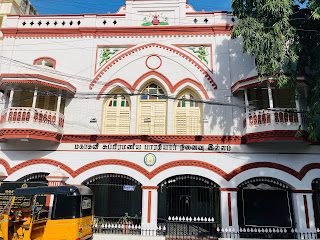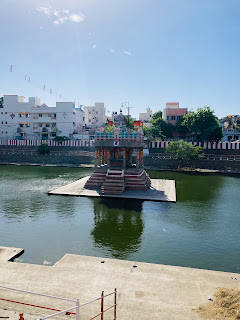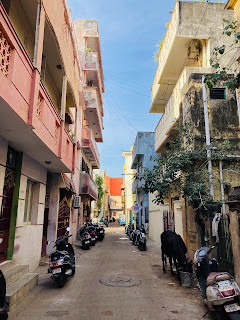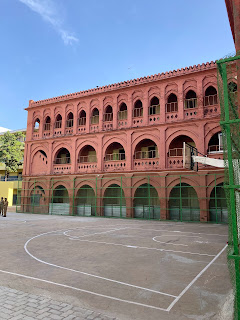Reposted from Medium
Imagine a typical Chennai (Madras) morning. 7 am and the temperatures are already in the early 30s (Celsius). I don’t have to state that the sun is shining (it usually is!). My father and I are walking along Beach Road, and I am glad for the brisk sea breeze that is somewhat tempering the feeling of being in a hot oven.
For the past few years, Appa has been taking members of the extended family on a walk down nostalgia lane with his detailed posts on memories from the 1940s-1960s in Triplicane and Adayar. The family WhatsApp group, fondly named “Annapoorna” after the house where my father and his siblings grew up, like most family groups, tends to be a repository of happy birthday and happy anniversary wishes, but the memory train has engaged and revitalized it into something more meaningful. My dormant interest in documenting our family history has been rekindled, and today, I have asked Appa to give me a family history tour in this part of my hometown.
My paternal grandfather hailed from a village called Chandrasekarapuram near Kumbakonam, Tamil Nadu. He was born in 1910. He was a journalist and a staunch Gandhian. A Congress member, I have heard he only wore Khadi until he died in 1975. He was a keen political observer and well-known to the political bigwigs of the day, while never holding a formal position in the party. He died some months before I was born, but I have always been fascinated with our origin story. Who are we, where did we come from, and what happened in those early years that influenced the course of everyone in our rather large family?
Our first stop on this history tour is “Thilagar Thidal” or Tilak Ghat, an area of Marina Beach that bore witness to many impassioned speeches calling for independence. This spot is right opposite the deep red imposing structures of Presidency College, where my father got his Bachelor’s and Master’s degrees. We walk through a small part of what is evidently a large campus. The buildings are beautiful, but the grounds are so poorly-maintained. This is a 180-year institution with a huge list of notable alumni, including TWO Nobel laureates (S Chandrasekaran and CV Raman) and C Rajagopalachari. Sarvapalli Radhakrishnan used to teach there. The place is a monument to 2 centuries of advancement in political, social, and scientific thought, and it lies in a pitiable state with plastic water bottles, polythene carry bags, dead leaves and plants, and general litter visible everywhere.
We step out of the college and start walking down Pycrofts Road, now renamed Bharathi Salai, the arterial road cutting through Triplicane (Thiruvallikeni). While I lived in India, I never gave a second thought to the hazards on the road or the need to keep all senses on high alert while navigating potholes, electricity pylons, cows, autos, buses, motorbikes, and people. How beautifully nimble all of us are — human, beast, and vehicle! I was glad I could still easily transition to the old ways, keenly observing life on the streets while deftly avoiding the generous helpings of cow dung on the ground!
The Triplicane area is among the oldest settled parts of Chennai. With the 8th-century Sri Parthasarathy Swami temple as its locus, the area is a multi-cultural neighbourhood with Vaishnavite Brahmin, Jain, and Muslim influences. It is a hub of commerce, religion, and living, breathing history and culture.
Our first stop in Triplicane is Raja Hanumantha Lala Street, where my father lived for the first few years of his life (maybe till he was 5–6 years old). He hasn’t been able to locate the exact house, but we saw the Siva temple, which was a few doors away, and the Corporation school where he and his brother started their education. In the early 50s, they moved to SMV (Sundaramoorthy Vinayagar) Koil Street to a bigger house with a verandah, large hall, 3–4 rooms, and a terrace. It needed to be that large to accommodate 4 adults and 7 children! Not to mention the relatives who kept coming and going. The house does not exist anymore but has been torn down to make way for a bigger, more modern dwelling.
On Big Street (Veeraraghavan Street) off Pycrofts Road is the venerable Hindu High School, where my father studied from Grade 5-SSLC. He says when he was a student there, the school was already 100 years old, populated mostly by Brahmin boys with tuft and dhoti-wearing male teachers. It was a 10-minute walk from the house. Interesting to imagine those days with few cars on the road, no autos, motorbikes, but only hand-pulled and cycle rickshaws. Many more cows!!! People walked or cycled everywhere, or walked to the nearest public transport option (tonga, rickshaw, bus, or tram). The women worked hard at cooking, cleaning, and caregiving. I recently read RK Narayan’s autobiography, where he speaks of taking long walks along Beach Road. No wonder they were all able to digest those big meals and keep a trim figure!
Our last stop in Triplicane is, of course, the Parthasarathy temple. En route, we stop to click a pic of the home and memorial of the great Tamil poet and activist, Subramania Bharathi. Partha is majestic and handsome, and the sanctum sanctorum seemed to be air-conditioned! A welcome respite from the heat outside. The area around the temple is full of name boards like Rangarajan (Chartered Accountant) and Srinivasan (Advocate). Not a single obviously Shaivite name in sight, and bare-chested Iyengar mamas are much in evidence!
There is more to see, but it would require a longer walk. We have seen the “Chinna Kadai” (small shop), a shop owned by my grandfather, where my dad used to be in charge during his school days, but the “Periya Kadai” (big shop), where my Periappa (father’s elder brother) was in charge, was some distance away. I guess this is what we call an “internship” these days!
Hearing my dad talk about his days playing truant from school, walking merrily along these streets unsupervised, and spending entire days bouncing a ball inside the Parthasarathy temple, I am fascinated by what I have not experienced, or experienced very differently- those tight bonds of community, the culture of sharing material things and responsibilities, the carefree days of childhood undiluted by any safety concerns. My childhood was vastly different from my father’s, and my children’s bear no resemblance even to mine.
No one wants to turn back the clock, but learning about our families’ histories can certainly help with identifying best practices for living and being. What can we learn from the experiences of our elders? Migration, the generation gap, and modern lifestyles have taken a toll on family connections in any case; however, I don’t want to have genealogical amnesia. I want to have a small window, if nothing else, into the unique memories of past generations. Reminiscence and nostalgia are pleasurable but useless exercises if they don’t help us reflect on our own journeys. And if there is one thing that we learn as we age, it is that there is no making sense of who were are if we don’t know the journeys of those who came before us.























No comments:
Post a Comment
I would love to hear your thoughts :)